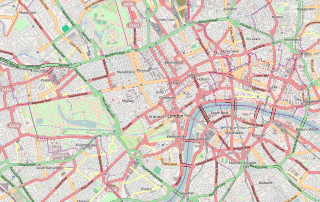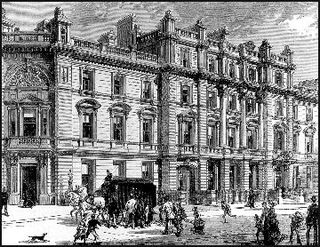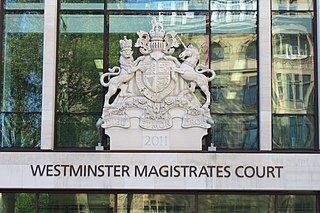
The City of Westminster is a London borough with city status in Greater London, England. It is the site of the United Kingdom's Houses of Parliament and much of the British government. It contains a large part of central London, including most of the West End, such as the major shopping areas around Oxford Street, Regent Street, Piccadilly and Bond Street, and the entertainment district of Soho. Many London landmarks are within the borough, including Buckingham Palace, Westminster Abbey, Whitehall, Westminster Cathedral, 10 Downing Street, and Trafalgar Square.

The West End of London is a district of Central London, London, England, west of the City of London and north of the River Thames, in which many of the city's major tourist attractions, shops, businesses, government buildings and entertainment venues, including West End theatres, are concentrated.

Haymarket is a street in the St James's area of the City of Westminster, London. It runs from Piccadilly Circus in the north to Pall Mall at the southern end. Located on the street are the Theatre Royal, His Majesty's Theatre, New Zealand House, a cinema complex and restaurants.

The Marble Arch is a 19th-century white marble-faced triumphal arch in London, England. The structure was designed by John Nash in 1827 as the state entrance to the cour d'honneur of Buckingham Palace; it stood near the site of what is today the three-bayed, central projection of the palace containing the well-known balcony. In 1851, on the initiative of architect and urban planner Decimus Burton, a one-time pupil of John Nash, the arch was relocated to its current site, near the northeast corner of Hyde Park, so that expansion of Buckingham Palace could proceed.

Westminster Bridge is a road-and-foot-traffic bridge over the River Thames in London, linking Westminster on the west side and Lambeth on the east side.

Central London is the innermost part of London, in England, spanning the City of London and several boroughs. Over time, a number of definitions have been used to define the scope of Central London for statistics, urban planning and local government. Its characteristics are understood to include a high-density built environment, high land values, an elevated daytime population and a concentration of regionally, nationally and internationally significant organisations and facilities.

Baker Street is a street in the Marylebone district of the City of Westminster in London. It is named after builder William Baker, who laid out the street in the 18th century. The area was originally high class residential, but now is mainly occupied by commercial premises.

Bow Street Magistrates' Courtand Police Station each became one of the most famous magistrates' courts and police stations in England.
Senior District Judge Timothy Henry Workman is a retired British judge, a long-term stipendiary magistrate who served as Senior District Judge for England and Wales.

The Landmark London is a five-star hotel on Marylebone Road on the northern side of central London, England, in the City of Westminster. It was originally opened by the Great Central Railway, as the Hotel Great Central. As one of London's railway hotels it declined after the advent of the motor car, and served as a military convalescent home during the Second World War, and later the headquarters of the British Railways Board. It reopened as a hotel in 1993.
There are several long-established Nordic churches in London. All seek to provide Lutheran Christian worship and pastoral care to their respective national communities in their own languages. Many of the churches also organise language classes and organise a wide range of social activities.

Westminster Hospital was a hospital in London, England, founded in 1719. In 1834 a medical school attached to the hospital was formally founded. In 1939 a newly built hospital and medical school opened in Horseferry Road, Westminster. In 1994 the hospital closed, and its resources were moved to the new Chelsea and Westminster Hospital at the old St Stephen's Hospital site on Fulham Road.

Marylebone High Street is a shopping street in London, running sub-parallel to Baker Street and terminating at its northern end at the junction with Marylebone Road. Given its secluded location, the street has been described as "the hidden wonder of the West End" and it was voted Best Street in London in 2002 by listeners of BBC Radio 4, winning praise for its being "a haven in the middle of the frantic city." Marylebone High Street was also an electoral ward of the City of Westminster from 2002 to 2022; its population at the 2011 Census was 10,366.

Imperial Chemical House is a Grade II listed building situated on Millbank, London, England, near the west end of Lambeth Bridge. It was designed by Sir Frank Baines in the neoclassical style of the inter-war years, and constructed between 1927 and 1929 as the headquarters for the newly created Imperial Chemical Industries (ICI). Thames House, the next building south along Millbank, across Horseferry Road, was also designed by Baines and constructed at the same time.

Horseferry Road is a street in the City of Westminster in central London running between Millbank and Greycoat Place. It is perhaps best known as the site of City of Westminster Magistrates' Court. The ubiquity of the magistrates' court in newspaper crime reports means that the road name has wide recognition in the UK. Other notable institutions which are or have been located on Horseferry Road include Broadwood and Sons, the Gas Light and Coke Company, British Standards Institution, the Royal College of Veterinary Surgeons, the Burberry Group, the Environment Agency headquarters in Horseferry House, the National Probation Service, the Department for Transport at no. 33 and Channel 4. The Marsham Street Home Office building backs on to this road.

The New Road was a toll road built across fields around the northern boundaries of London, the first part of which opened in 1756. The route comprises the modern-day A501.

Charlotte Street is a street in Fitzrovia, historically part of the parish and borough of St Pancras, in central London. It has been described, together with its northern and southern extensions, as the spine of Fitzrovia.

Westminster Magistrates' Court is a magistrates' court at 181 Marylebone Road, London. The Chief Magistrate of England and Wales, who is the Senior District Judge of England and Wales, sits at the court, and all extradition and terrorism-related cases pass through it. The court opened on 22 September 2011 as a replacement for the City of Westminster Magistrates' Court.

The Paviours Arms was a public house in Neville House, Page Street, City of Westminster, that was said to be London's most complete Art Deco pub.

Seymour Place is a street in Marylebone in Central London. Located in the City of Westminster, it runs north from Seymour Street until it meets Marylebone Road, where it becomes Lisson Grove. It is crossed by Crawford Street, George Street, and York Street and runs parallel to Gloucester Place, which lies to its east. Its southern end is about 180 metres northwest of Marble Arch and about 40 metres east of Edgware Road.



















